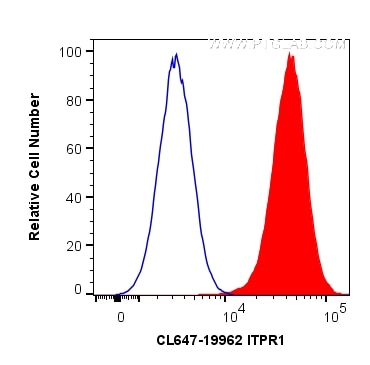Tested Applications
| Positive FC (Intra) detected in | HepG2 cells |
Recommended dilution
| Application | Dilution |
|---|---|
| Flow Cytometry (FC) (INTRA) | FC (INTRA) : 0.20 ug per 10^6 cells in a 100 µl suspension |
| It is recommended that this reagent should be titrated in each testing system to obtain optimal results. | |
| Sample-dependent, Check data in validation data gallery. | |
Product Information
CL647-19962 targets ITPR1-specific in FC (Intra) applications and shows reactivity with human, mouse, rat samples.
| Tested Reactivity | human, mouse, rat |
| Host / Isotype | Rabbit / IgG |
| Class | Polyclonal |
| Type | Antibody |
| Immunogen |
Peptide Predict reactive species |
| Full Name | inositol 1,4,5-triphosphate receptor, type 1 |
| Calculated Molecular Weight | 314 kDa |
| Observed Molecular Weight | 290-300 kDa |
| GenBank Accession Number | NM_001099952 |
| Gene Symbol | ITPR1 |
| Gene ID (NCBI) | 3708 |
| RRID | AB_2934937 |
| Conjugate | CoraLite® Plus 647 Fluorescent Dye |
| Excitation/Emission Maxima Wavelengths | 654 nm / 674 nm |
| Form | Liquid |
| Purification Method | Antigen affinity purification |
| UNIPROT ID | Q14643 |
| Storage Buffer | PBS with 50% glycerol, 0.05% Proclin300, 0.5% BSA, pH 7.3. |
| Storage Conditions | Store at -20°C. Avoid exposure to light. Stable for one year after shipment. Aliquoting is unnecessary for -20oC storage. |
Background Information
ITPR1, also named as INSP3R1 and IP3R, belongs to the InsP3 receptor family. It is a receptor for inositol 1,4,5-trisphosphate which is a second messenger that mediates the release of intracellular calcium. Defects in ITPR1 are the cause of spinocerebellar ataxia type 15 (SCA15). The antibody has no cross reaction with ITPR2 and ITPR3.
Protocols
| Product Specific Protocols | |
|---|---|
| FC protocol for CL Plus 647 ITPR1-specific antibody CL647-19962 | Download protocol |
| Standard Protocols | |
|---|---|
| Click here to view our Standard Protocols |




